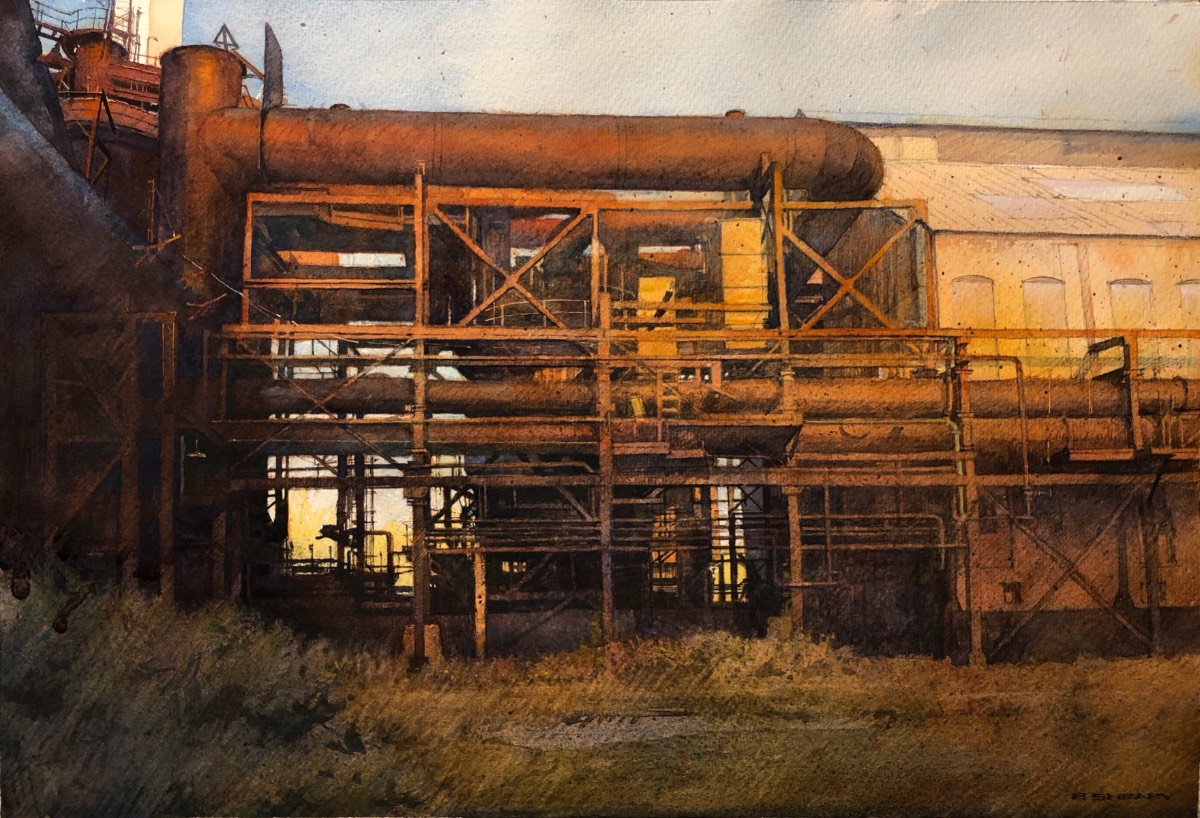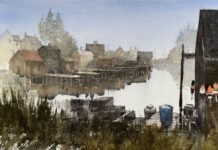By Bob Bahr

A masterclass on what watercolor can do, Carrie Furnace #6 has the crisp lines and dead-accurate drawing of a realist painting, but with the kind of expressive color and varied technique that can bewitch the eye of a viewer with a more poetic sensibility. Wonderfully loose washes give broad areas a sense of variety and texture that would take three times the work to look natural with oil paints. Use of a fan brush provides more broken color and texture. Lights are preserved in the early stages to allow the white of the paper to illuminate from behind layers of paint and, because Richard Sneary is not a strict traditionalist, white gouache provides a few scant highlights.
Even though the Pennsylvania steel mill offers the scrumptious textures of rust and crusty metal, one could argue that the depiction of the light in the painting is one of its biggest strengths. The warm sun of the golden hour elevates the literally tough subject matter in this winner of the Bud and Gretchen Marble Medal given by the American Watercolor Society in 2021.

This effect is yet more prominent in Carrie Furnaces #4, in which Sneary doesn’t hesitate to let the yellow light and blue shadows of the steel structure blend into somewhat startling greens. “I did see some of that green when I was looking at the scene,” he says. “I was interested in that figure going up the ladder in the round cage, which gave some sense of the scale. The Carrie furnace is so massive that it is almost unbelievable. It is a somewhat dimly lit area at this time of day, with the lights off because they were not working anymore. I liked the glare and dust; I remember looking at the sun and how it burnt out some things. The yellow-greens were mostly about showing where the light was coming from. The furnace itself was all black-blue and rust. It became about texture, changing colors, and contrast.”
And One From the Field
In Moraine Park, Sneary shows how to break one rule and still have a strong painting by relying on another one. The mountains have a lovely softness to them, with washes of color suggesting the variety in the rocks and vegetation, without the sharp details that would destroy the sense of depth. Working en plein air, Sneary confides that the weather that was coming in helped to create this effect in the actual scene. The fence line in the foreground could very well have produced a distracting bit of detail, but its broken line helps the eye move freely about the composition. On the right in the distant middle ground, a few evergreens offer strong darks, and yet they recede. The artist attributes this to careful use of color temperature and attention to the relative darkness of the evergreens against the slightly lighter foothills.

“The foreground was really only about the light yellow field,” he explains. “I made the ranch and woods a bit stronger against it. The darks in the middle ground don’t come forward because they are in front of fairly dark darks, so it sits in depth. If it looks like a middle ground dark will come forward, I back off that element and come back in with some added dark behind it. It’s always a little bit of an experiment, and you never know if you will get it. Plenty of experiments don’t work.”
In Watercolor Mastery — Light & Shadow, you can watch Richard Sneary play with light and shadow, with shape and edges, and see how he creates drama by expertly manipulating paint.







